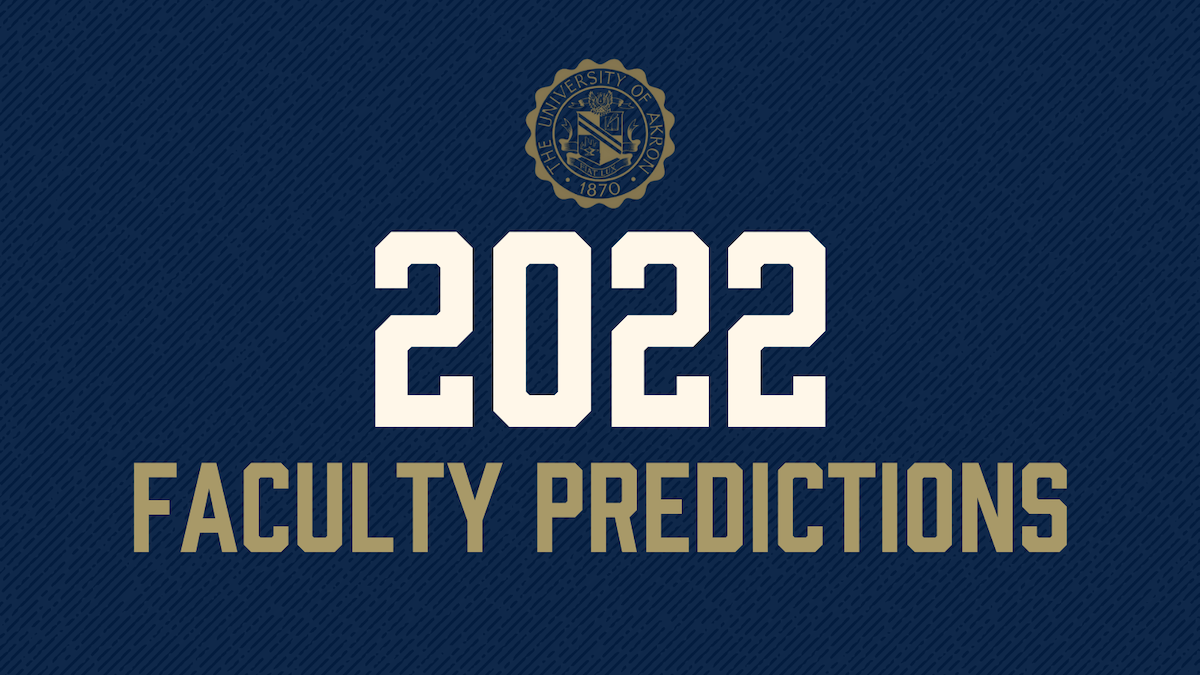GOP control, more road construction and viral dance routines: what we can expect in 2022
 December 2020 was a time of great optimism. COVID-19 vaccines were beginning to roll out, giving us hope about a possible end to the pandemic. The start of a Joe Biden presidency looked promising – with a strong economy and vaccines on the horizon, there was hope for a united nation. And teens and young adults were spending plenty of time on the social media app TikTok.
December 2020 was a time of great optimism. COVID-19 vaccines were beginning to roll out, giving us hope about a possible end to the pandemic. The start of a Joe Biden presidency looked promising – with a strong economy and vaccines on the horizon, there was hope for a united nation. And teens and young adults were spending plenty of time on the social media app TikTok.
One year later, uncertainty abounds. At the end of 2021, we’re heading into another wave of COVID-19 variants. Prices for goods and services are rising due to inflation and supply-chain issues. And now, it seems, just about everyone knows what a #ForYouPage is.
Although we’ve learned in the past few years that it’s incredibly hard to make predictions about things we still don’t fully understand – how and why a virus behaves the way it does, for example – faculty experts from The University of Akron have some thoughts about what we could see in the next 12 months. Here are a few predictions for 2022.
Midterm elections
Prediction: Amid high stakes for the Biden administration and investigations into the Trump administration, the GOP will win control of the House.
By Dr. David Cohen, professor of political science, Buchtel College of Arts and Sciences; director of The University of Akron Applied Politics Program; fellow, Ray C. Bliss Institute of Applied Politics
 Set against the backdrop of the November midterm election, 2022, like every year since 2017, promises to be one of controversy and conflict for our polarized American political system.
Set against the backdrop of the November midterm election, 2022, like every year since 2017, promises to be one of controversy and conflict for our polarized American political system.
With the Democrats controlling the U.S. House of Representatives by a slim eight-seat margin and a U.S. Senate evenly split between the parties, the stakes could not be higher for the Biden administration’s legislative agenda and the future direction of the country. If history and political science research is any guide, Democrats will be hard-pressed to maintain control of the House as only three times since 1934 (1998 and 2002 were the other two years) has the president’s party actually achieved a net gain of seats in a midterm. One thing that could offset this trend is a resurgent economy with decreasing inflation and/or the end of the COVID-19 pandemic — neither of which seems particularly likely.
One thing that is likely is the continuation of the investigation by the U.S. House Select Committee to Investigate the January 6th Attack on the United States Capitol. The investigation promises to be must-watch TV as public hearings will commence and subpoenas will continue to be issued as the committee dives deep into the causes of the Jan. 6 insurrection, including former President Donald Trump’s efforts to perpetrate the “Big Lie” about the 2020 presidential election and his role in encouraging the riot.
One would think that a former president who lost reelection under a cloud of scandal and facing numerous legal challenges would have no future in American politics; however, these are not normal times and Trump is not a typical ex-president. As things currently stand, if Trump decides to run for president in 2024, it is very likely he will win the Republican Party’s nomination. Expect Trump to continue to hint that he will indeed run, though no official announcement is likely in 2022.
Finally, the specter of COVID-19 will continue to color everything in American politics. As variants emerge like delta did in the summer of 2021 and as omicron recently has, elected officials and policymakers, public health and medical personnel, and the public will continue to grapple with the responses to this historic plague. Unfortunately, life-saving measures designed to slow the spread of disease and help individuals recover from COVID-19 such as vaccines and wearing masks indoors in public spaces have become politicized, hindering the ability of policymakers and public health officials to control the pandemic. This politicization of COVID-19 response will continue unabated throughout 2022.
The environment
Prediction: Emerging technologies will help make progress in cleaning up global waste, including a COVID-related surge in disposables usage.
 By Dr. James Eagan, assistant professor, School of Polymer Science and Polymer Engineering, College of Engineering and Polymer Science
By Dr. James Eagan, assistant professor, School of Polymer Science and Polymer Engineering, College of Engineering and Polymer Science
It would seem all 2020 predictions were thrown askew due to the global pandemic. I had predicted a decline in single use plastics only to find in 2020 and 2021 that billions of polyester facemasks, plastic vaccine syringes, and nitrile gloves would be used once before being landfilled or incinerated. Even reusable bags were actively discouraged at the grocery store.
However, despite this continued rise in plastic usage we made significant progress in cleaning up our global waste. The Ocean Cleanup organization launched a fleet to reclaim the Great Pacific Garbage Patch and began commercial sale of these recycled plastics. The United Nations met for two weeks at the Glasgow Summit to refine the Paris Climate Accord to stop carbon dioxide emissions globally. In our research lab here at UA, we made a discovery that enables the synthesis of biodegradable plastics from the chemical polymerization of carbon dioxide that has the potential to turn greenhouse gases into high-value products.
As we move into 2022, I predict technologies will emerge that are increasingly focused on remediation, as well as conservation, of our environment.
Infrastructure
Prediction: The infrastructure bill may mean more construction – and more opportunities for civil engineering students.
By Dr. Ala Abbas, professor of civil engineering, College of Engineering and Polymer Science
 Over the last couple of years, one of the least contentious topics between Democrats and Republicans was the need to invest in our nation’s infrastructure. This resulted in the recently passed Infrastructure Investment and Jobs Act, which represents the largest long-term infrastructure investment in nearly a century. This act will provide funding to repair and rebuild roads and bridges, enhance roadway safety, improve public transportation, modernize and expand passenger rail, improve freight rail efficiency and safety, upgrade airports, expand the nation’s port infrastructure and build a network of electric vehicle chargers to facilitate long-distance travel.
Over the last couple of years, one of the least contentious topics between Democrats and Republicans was the need to invest in our nation’s infrastructure. This resulted in the recently passed Infrastructure Investment and Jobs Act, which represents the largest long-term infrastructure investment in nearly a century. This act will provide funding to repair and rebuild roads and bridges, enhance roadway safety, improve public transportation, modernize and expand passenger rail, improve freight rail efficiency and safety, upgrade airports, expand the nation’s port infrastructure and build a network of electric vehicle chargers to facilitate long-distance travel.
Based on most recent estimates, Ohio is expected to receive around $10 billion in federal funding during the next five years for its highways and bridges, which represents a 30 percent increase over current funding for this purpose. In anticipation of this investment and upcoming projects, companies in Ohio and elsewhere have been actively recruiting and training new civil engineers. Combined with the effects of the pandemic, which resulted in a large number of engineers choosing to retire early or change jobs, the projected increase in infrastructure projects has created a historically high demand for entry-level civil engineers. I expect this trend to continue in 2022 and subsequent years.
COVID-19
Prediction: Get familiar with the Greek alphabet – more COVID variants after omicron are expected in the coming year.
By Dr. R. Joel Duff, professor of biology, Buchtel College of Arts and Sciences
 One might think the only sure prediction about the ongoing pandemic is that it will be unpredictable in the coming year, but I don’t believe that is true. In December of 2020 most people, including myself, would have said that 2021 was going to be better year – yet the pandemic continued unabated even if our behaviors toward it have changed.
One might think the only sure prediction about the ongoing pandemic is that it will be unpredictable in the coming year, but I don’t believe that is true. In December of 2020 most people, including myself, would have said that 2021 was going to be better year – yet the pandemic continued unabated even if our behaviors toward it have changed.
Unfortunately, it is too easy to predict that 2022 will likely be no better than 2021. We have a new variant, known as omicron, at our doorstep. By the end of the year another Greek letter will be joining that one. Omicron may or may not be as virulent as delta but it seems primed to replace delta and generate new waves of infections. I predict that for unvaccinated and previously unaffected people the incidence of severe outcome will be similar to past variants and that vaccinated people – especially those who have had their boosters – will continue to be protected from severe outcomes. That doesn’t seem any worse than our present state, but I predict the ability of omicron to reinfect those who had COVID a year ago along with those without boosters will provide ample opportunities for rapid spread of this new variant.
It is not difficult to predict that human behavior is unlikely to change from its current trajectory of greater and greater apathy toward the pandemic and continued resistance to initial and additional vaccinations. The lack of our will to use the effective tools we have to combat the pandemic, combined with omicron’s ability to re-invade the population, will allow the pandemic to continue with new waves of cases, hospitalizations and deaths, with many places possibly experiencing even higher hospitalizations and deaths than before.
Social media
Prediction: TikTok will continue to boom, while other apps consider users’ mental health.
By Dr. Rhiannon Kallis, assistant professor of communication, Buchtel College of Arts and Sciences
 The social media landscape is constantly changing in terms of platform popularity, viral trends and capabilities. Right now, we are seeing a steady increase in the use of the video-sharing app TikTok, which has 1 billion users globally according to the company. While in five years, or even by the end of 2022, a new app could sweep in and take over in popularity, TikTok has currently staked out a sizeable portion of social media real estate and created a celebrated algorithm that keeps users returning to their #ForYouPage. From dance trends to viral products (#TikTokMadeMeBuyIt) and having a dedicated channel on Sirius XM, TikTok only seems to be growing as we move into 2022, with no signs of slowing.
The social media landscape is constantly changing in terms of platform popularity, viral trends and capabilities. Right now, we are seeing a steady increase in the use of the video-sharing app TikTok, which has 1 billion users globally according to the company. While in five years, or even by the end of 2022, a new app could sweep in and take over in popularity, TikTok has currently staked out a sizeable portion of social media real estate and created a celebrated algorithm that keeps users returning to their #ForYouPage. From dance trends to viral products (#TikTokMadeMeBuyIt) and having a dedicated channel on Sirius XM, TikTok only seems to be growing as we move into 2022, with no signs of slowing.
While social media users, especially young adults, spend considerable time on platforms, users’ well-being is coming more into focus. Instagram has introduced the “Take a Break” feature that encourages users to step away from the platform after sustained use, has addressed ads and promotions targeting young people for beauty-related products and has put restrictions on unwanted tagging for young users. New parental features are set to be released in the coming year. Some companies, such as Lush cosmetics, are also getting involved and have begun to disassociate their brand with certain social apps because of the concern over their audience’s well-being while using these apps. With continued attention to the impact of social media on users’ well-being, companies and platforms are likely going to continue finding ways to improve users’ experiences while engaging on these apps.
Foreign policy
Prediction: The U.S. and China face a tense year over Taiwan.
 By Dr. Karl Kaltenthaler, professor of political science, Buchtel College of Arts and Sciences; director of the Center for Intelligence and Security Studies
By Dr. Karl Kaltenthaler, professor of political science, Buchtel College of Arts and Sciences; director of the Center for Intelligence and Security Studies
The U.S.-China bilateral relationship is crucial to global stability. Both countries’ leaders view the other as intending to dominate a multi-faceted global competition and the two countries are in a state of profound mutual distrust.
Presently, the most contentious issue between the U.S. and China is Taiwan. China views Taiwan as a renegade province and a matter of internal politics. The U.S. says it recognizes one China with Beijing as its capital. But the U.S. is friendly with Taiwan and warns China against trying to take Taiwan by force. Lately, the Chinese government has taken a much more hostile posture toward Taiwan in both word and deed. It has sent bombers into Taiwanese airspace and practiced war games clearly intended to convey the message that it can successfully invade Taiwan.
Does China intend to invade Taiwan? It is difficult to know for sure but there is a less than 50 percent chance it would do so in 2022. While China is clearly becoming more aggressive toward Taiwan, that may well be an attempt to play to domestic audiences in China that like the nationalistic bravado of the Chinese leadership. It may also be an attempt to intimidate Taiwan into starting serious talks with China about reunification.
A Chinese invasion of Taiwan would very likely have very negative effects on China’s economic prosperity, which is primarily what gives the Chinese leadership its legitimacy. Also, an invasion of Taiwan carries the risk of provoking a shooting war with the U.S., something that is fraught with risk for China. Thus, in 2022, we can expect more Chinese saber-rattling toward Taiwan and more U.S. signaling that an invasion would cost China dearly. We can be sure that 2022 will be another very tense year in U.S.-Chinese relations.
Economic policy
Inflation will get worse – but it will get better.
By Dr. Michael DeDad, assistant professor of economics, College of Business
 While we are still below the high inflation of the 1970s, prices are growing at the fastest rate in decades due to an economy that has strengthened more quickly than suppliers were prepared for. This should continue in the months following the holiday spending season but by the end of 2022, inflation will likely start to subside on its own and/or with significant help from the Federal Reserve.
While we are still below the high inflation of the 1970s, prices are growing at the fastest rate in decades due to an economy that has strengthened more quickly than suppliers were prepared for. This should continue in the months following the holiday spending season but by the end of 2022, inflation will likely start to subside on its own and/or with significant help from the Federal Reserve.
Ideally, inflation will come down naturally as suppliers catch up with demand. While overall inflation was 6.8% from November 2020 to November 2021, this included prices for used cars and trucks that were up 31.4% due to the persisting computer chip shortage. Working out supply chain issues in sectors like this will help to reduce overall inflation while allowing the economy to remain strong through 2022. Lower demand, caused by the effects of fiscal stimulus wearing off and lower wage growth as more workers reenter the labor force might also help to dampen inflation.
Even if these do not reduce inflation, the Federal Reserve has powerful tools to reduce it toward a 2% target. While the Federal Reserve is already winding down its support for the economy due to a strong labor market and rising inflation, it will likely need to act more forcefully than it has been anticipating in order to reduce inflation expectations, which can be self-fulfilling. If conditions force the Federal Reserve to raise interest rates quickly and by a large magnitude, then reduced inflation could come at the cost of an economy slowed down to the point of recession. Uncertainty revolving around the emergence of new variants of the coronavirus further complicates the strategy.
Thus, inflation is likely to subside one way or another, but we should all be hoping for the options that do not involve a recession in 2022.
Global supply chain
Prediction: The supply chain will start to flow again, with push toward technology adoption, digitization and sustainable practices
By Dr. Mahesh Srinivasan, associate professor of management, College of Business; director, Institute for Global Business
People don’t like change, whether due to uncertainty, confusion, ambiguity, concern over the loss or simply that the change is not really in their interest. When a sports organization changes the name it had been using since 1915, there is bound to be fan resistance toward the new name. For some fans, it is not just about name change. It’s about years of family memories and experiences with Cleveland Indians baseball taken away and replaced with the Cleveland Guardians.
Nevertheless, rebranding is a quite prevalent business strategy in professional sports. In recent years the Washington Football Team, Akron RubberDucks, World Wresting Entertainment, to name just a few, have undergone rebranding. Quite frequently, sports organizations make modifications to their logos, colors, names or combinations of these for many purposes, including new brand identity for the organization.
How will fans in Northeast Ohio react to the change? Will all fans show resistance in the same way? Probably not. There will be, for some time, resistance mainly because this region has many highly identified Cleveland Indians fans, and it is anticipated that fans with high team identification may exhibit negative attitudes to rebranding whether it is the name and/or logo, color or any components associated with the rebranding process. However, I still expect merchandise sales with the new team name and logo to be strong because of the high level of team identification that many people here in Northeast Ohio exhibit. Also, the rebranding strategy by the Cleveland Guardians emphasized regional pride with the concept of modernization, which I believe will also help merchandise sales.
Overall, there will be resistance to the name change. However, baseball fans in this area will support the Cleveland Guardians with passion, as they have done for generations.
Media contact: Cristine Boyd, 330-972-6476 or cboyd@uakron.edu
